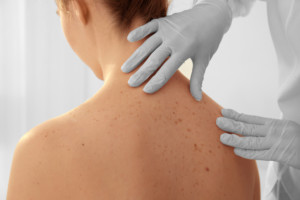 You might assume that skin cancer would be one of the easiest cancers to spot. After all, skin is your biggest organ and it’s readily visible, so surely you’d notice if something was wrong. Unfortunately, it may not be that simple.
You might assume that skin cancer would be one of the easiest cancers to spot. After all, skin is your biggest organ and it’s readily visible, so surely you’d notice if something was wrong. Unfortunately, it may not be that simple.
As you grow and age, your skin is constantly changing. In fact, the human body gets rid of about 1.5 pounds of skin each year to make room for fresh cells. This cycle of constant change means you might not notice a small difference in a bump you’ve had for years or a mole that’s beginning to look a little strange around the edges.
The good news is that the more you know about the factors that can signal potential skin cancer, the easier it will be for you to decide when a trip to a professional is in your best interests.
The Different Types of Skin Cancer: Melanoma vs. Non-Melanoma
The first thing to note when you’re looking for early signs of skin cancer is that there is a distinction between “melanoma” (the most aggressive type of skin cancer) and “non-melanoma” strains of the disease.
Non-melanoma skin cancers are the most common, and they begin within the deeper layers of your skin, which means that you might not notice any symptoms straight away. Melanoma cancers, on the other hand, are distinctly more dangerous and occur within the upper and middle layers of the skin.
Melanoma cancers are more aggressive because they can often spread to other parts of the body, leading to a more comprehensive disease. Both types of skin cancer can occur anywhere on the body, but they often appear most on areas frequently exposed to the sun.
Non-Melanoma Skin Cancer Symptoms
While disease can present differently depending on the patient in question, non-melanoma skin cancer symptoms often include an unusual growth that doesn’t heal by itself. The growth may appear as a rash or an abnormally-colored patch of skin. Over time, as the cancer begins to progress, the size or texture of the skin may change, and the spots might begin to ooze or bleed.
Common forms of non-melanoma skin cancers include:
- Basal cell carcinomas: These often appear as skin-colored bumps or pale patches of skin. As the cancer develops, it might turn more brownish in shade or begin to bleed in some areas.
- Squamous cell carcinomas: These cancers can also develop as firm lumps in the skin. They often feel rough in texture or develop a scaly patch around them, similar to eczema. Unlike standard rashes, these lesion-like patches gradually get worse with time.
- Merkel cell carcinomas: These cancers appear as flesh-colored or red moles that grow surprisingly fast. Merkel cell carcinomas usually thrive on patches of the skin consistently exposed to sunlight, including the face, shoulders, and scalp.
Melanoma Skin Cancer Symptoms
Melanoma, the more dangerous type of skin cancer, can appear on the skin either in the form of a new spot or a mole that suddenly changes in appearance. While it can be difficult to tell the difference between a cancerous and non-cancerous mole at first glance, normal moles are often small, even in color, and consistent.
Dermatologists can separate cancerous moles from “normal” blemishes on the skin using a method called the “ABCDE” test. Learning the ABCDEs can help you to pinpoint the early signs of dangerous tumors.
ABCDE stands for:
- A: Asymmetrical: A standard mole is small and circular while a melanoma lesion looks strange, like a splotch of paint.
- B: Border: Non-cancerous moles have even borders, while melanoma lesions evolve over time, giving them outlines that are hard to define. It might look as though the color of the mole is seeping into your skin.
- C: Color: If the bump on your skin features multiple shades, this could be a warning sign of melanoma. Standard moles are usually all one color.
- D: Diameter: If something doesn’t seem right about your mole, you might want to measure it. Lesions caused by melanoma are usually more than 6 millimeters in diameter.
- E: Evolution: A healthy mole doesn’t change over time, but a melanoma lesion evolves. That’s why it’s so important to have regular skin checks with your doctor and perform them yourself at home.
What to Do About Suspicious Spots
Remember, your skin is constantly changing, repairing itself, and evolving. Just because you notice a new bump or a scab over a mole doesn’t mean you have to panic about cancer. However, if you notice any of the melanoma signs above, including a mole that feels itchy, develops a scab or crust, feels tender, or is growing in size, visit your doctor.
One way to help your doctor is by keeping track of the shape and size of your moles so that you can log changes throughout the years and supplement in-office skin checks. Knowledge is power when it comes to protecting yourself against skin cancer. Make sure you set up regular appointments with your doctor to keep skin safe.





